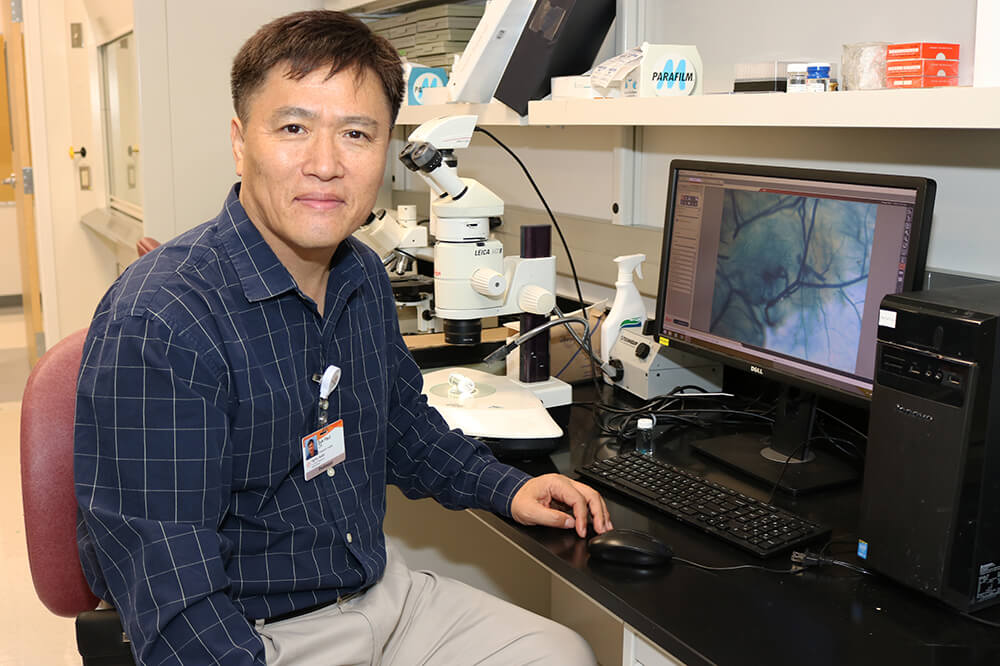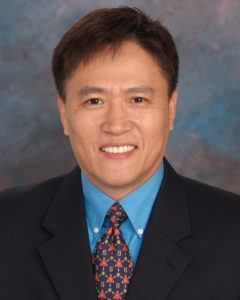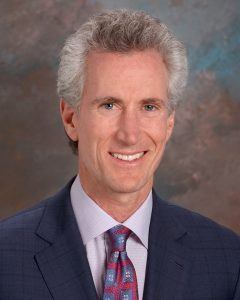
Barrow HHT Researcher Helps Advance Understanding of AVM Development
To create the Barrow Aneurysm and AVM Research Center, Dr. Lawton brought together faculty from the departments of neurosurgery, neurology, and neurobiology. He also recruited two new scientists from other institutions, including HHT researcher Dr. S. Paul Oh from the University of Florida.
What is HHT?
HHT, or hereditary hemorrhagic telangiectasia, is a disorder that causes arteriovenous malformations (AVMs) in multiple organs of the body. It affects about 1 in 5,000 people worldwide.

Professor of Neurobiology
AVM is an abnormal tangle of blood vessels in which arteries and veins are directly connected to each other instead of being linked by a network of smaller vessels called capillaries. Without the buffer of capillaries, blood flows from arteries to veins at a pressure that is too high for the veins to accommodate due to their thinner walls. This can cause the blood vessels to be abnormally dilated, tortuous, and prone to rupture.
When a blood vessel ruptures inside the brain, it causes a hemorrhagic stroke. While most strokes are ischemic, meaning they are caused by a clot, about 13 percent of all strokes are hemorrhagic.
“The dangers are that AVMs in the brain are often asymptomatic, so some people don’t even know they have an AVM until it ruptures,” Dr. Oh said. “The risk factors for rupture are not very well known.”
Anyone can develop a brain AVM, but they are much more common among people with HHT than in the general population. People with HHT may also develop AVMs in the lungs, liver, or spinal cord. Smaller vascular malformations called telangiectases may develop in the skin or in the mucous membranes, such as the nasal cavity and intestinal tract.
Depending on the location of their AVMs, people with HHT can experience various complications besides stroke, such as anemia, recurring nosebleeds, shortness of breath, migraine headaches, seizures, gastrointestinal bleeding, and even heart failure.
Understanding the Mechanisms of AVM Development
HHT is caused by a genetic mutation and inherited in an autosomal dominant fashion. This means a child only needs to inherit a mutation from one parent to develop HHT—a 50 percent chance.
Scientists have identified three genes involved in HHT: endoglin (ENG), activin receptor-like kinase 1 (ALK1), and SMAD-related protein 4 (SMAD4). They are all associated with the transforming growth factor-β (TGF-β) signaling pathway.
Before focusing on HHT, Dr. Oh studied TGF-β genes from a developmental biology perspective while working on his PhD at Harvard Medical School and training at Massachusetts General Hospital. In other words, he studied the role these genes play in the growth and development of humans.
“I wouldn’t say I chose HHT among many other diseases; I will say that I was kind of destined or happened to step my foot into it,” he said. “As I met HHT patients, I got motivated to find a cure or something that can increase their quality of life.”

President and CEO of Barrow
Dr. Oh’s research focuses on developing models of living tissue to study the molecular and cellular processes that lead to arteriovenous malformations and then using those models to assess potential therapies in a preclinical setting. He also helped develop a real-time imaging system to observe the entire course of AVM development in models.
“Paul Oh’s research was pivotal in creating the first experimental model of an arteriovenous malformation in living brain tissue, which we published together in 2011,” Dr. Lawton said. “This work and the model it produced gives us the ability to explore the pathogenesis of brain AVMs and new therapies for inoperable lesions.”
Some of Dr. Oh’s research has contributed to clinical trials, such as his work in anti-angiogenic therapy. He found that inheriting a gene mutation isn’t sufficient to cause AVMs; something else needs to happen to stimulate angiogenesis, or the formation of new blood vessels. He says blocking that secondary cue could be a strategy for potential therapies.
“Thanks to Paul’s work, we are transforming our thinking of brain AVMs from a poorly understood congenital lesion that patients are born with, to an acquired lesion that results from genetic mutations and abnormal angiogenesis,” Dr. Lawton said. “We are also moving to a point in the future when these formative pathways can be manipulated pharmacologically to cause AVM regression or to prime them for surgical resection. This research is in keeping with the rich history of AVM treatment at Barrow.”
Joining the Barrow Team
Dr. Oh decided to continue his work at Barrow after 20 years at the University of Florida for several reasons, including a desire to expand his research scope.
“I’ve been focusing more on skin AVMs and visceral AVMs, but I want to extend my research into brain AVMs,” he said. “I need to be in a place where a lot of brain AVM patients can be seen, and Barrow is the best place to work on brain AVMs.”
After I met HHT patients, I realized that my research shouldn’t just be research; it should really lead to some sort of tangible therapies.
Dr. S Paul Oh, Professor of Neurobiology
He also noted the collaboration with the Translational Genomics Research Institute (TGen) and access to Barrow’s imaging facilities as valuable resources for his work.
Dr. Oh brought with him a prestigious R01 grant from the National Institutes of Health and recently received two other major grants from the Department of Defense and Fondation Leducq.
While securing funding and publishing journal articles allow Dr. Oh to continue his laboratory work, his research into HHT and AVMs has become more than an interest in genomics and vascular biology.
“After I met HHT patients, I realized that my research shouldn’t just be research; it should really lead to some sort of tangible therapies,” he said.
